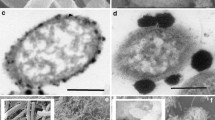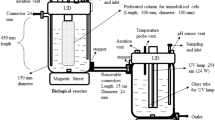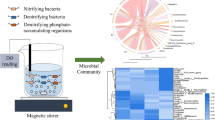Abstract
Heavy metals are removed by Serratia sp. via the activity of a cell-bound, atypical, PhoN-type acid phosphatase enzyme, which liberates HPO42- from a suitable organic phosphate donor, with the stoichiometric precipitation of heavy-metal cations (M2+) as insoluble MHPO4 at the cell surface. The present chapter describes the production of Serratia sp. cells (and biofilm) using different growth conditions (i.e., in media containing glycerol and lactose as the carbon source and as batch and continuous cultures). Also, it describes methods of immobilization of cells by entrapment, using polyurethane foam as the matrix, and by covalent coupling, using silanized ceramic Raschig rings and glutaraldehyde as a crosslinking agent. The removal of U from solution using a packed-bed reactor system is described as well as the removal of Ni2+or Co2+using a hybrid bioaccumulative and chemisorptive mechanism, known as “microbially enhanced chemisorption of heavy metals.”
Access this chapter
Tax calculation will be finalised at checkout
Purchases are for personal use only
Similar content being viewed by others
References
Pattanapipitpaisal, P., Mabbett, A. N., Finlay, J. A., et al. (2002) Reduction of Cr(VI) and bioaccumulation of chromium by Gram positive and Gram negative microorganisms not previously exposed to Cr-stress. Environ. Technol. 23, 731–745.
Jeong, B. C. and Macaskie, L. E. (1995) PhoN-type acid phosphatase of a heavy metal-accumulating Citrobacter sp.: resistance to heavy metals and affinity towards phosphomonoester substrates. FEMS Microbiol. Lett. 130, 211–214.
Jeong, B. C., Poole, P. S., Willis, A. C., and Macaskie, L. E. (1998) Purification and characterization of acid-type phosphatase from a heavy-metal-accumulating Citrobacter sp. Arch. Microbiol. 169, 166–173.
Jeong, B. C. and Macaskie, L. E. (1999) Production of two phosphatases by Citrobacter sp. grown in batch and continuous culture. Enzyme Microb. Technol. 24, 218–224.
Basnakova, G., Stephens, E. R., Thaller, M. C., Rossolini, G. M., and Macaskie, L. E. (1998) The use of Escherichia coli bearing a phoN gene for the removal of uranium and nickel from aqueous flows. Appl. Microbiol. Biotechnol. 50, 266–272.
Macaskie, L. E., Empson, R. M., Cheetham, A. K., Grey, C. P., and Skarnulis, A. J. (1992) Uranium bioaccumulation by a Citrobacter sp. as a result of enzymatically mediated growth of polycrystalline HUO2PO4. Science 257, 782–784.
Yong, P. and Macaskie, L. E. (1995) Enhancement of uranium bioaccumulation by a Citrobacter sp. via enzymatically-mediated growth of polycrystalline NH4UO2PO4. J. Chem. Technol. Biotechnol. 63, 101–108.
Macaskie, L. E. (1990) An immobilized cell bioprocess for the removal of heavy metals from aqueous flows. J. Chem. Technol. Biotechnol. 49, 357–379.
Macaskie, L. E., Yong, P., Doyle, T. C., Roig, M. G., Diaz, M., and Manzano, T. (1997) Bioremediation of uranium-bearing wastewater: biochemical and chemical factors influencing bioprocess applications. Biotechnol. Bioeng. 53, 100–109.
Bonthrone, K. M., Basnakova, G., Lin, F., and Macaskie, L. E. (1996) Bioaccumulation of nickel by intercalation into polycrystalline hydrogen uranyl phosphate deposited via an enzymatic mechanism. Nat. Biotechnol. 14, 635–638.
Basnakova, G. and Macaskie, L. E. (1997) Microbially enhanced chemiosorption of nickel into biologically synthesized hydrogen uranyl phosphate: a novel system for the removal and recovery of metals from aqueous solutions. Biotechnol. Bioeng. 54, 319–328.
Basnakova, G., Spencer, A. J., Palsgard, E., Grime, G. W., and Macaskie, L. E. (1998) Identification of the nickel uranyl phosphate deposits on Citrobacter sp. cells by electron microscopy with electron probe X-ray microanalysis and by proton-induced X-ray emission analysis. Environ. Sci. Technol. 32, 760–765.
Basnakova, G., Finlay, J. A., and Macaskie, L. E. (1998) Nickel accumulation by immobilised biofilm of Citrobacter sp. containing cell-bound polycrystalline hydrogen uranyl phosphate. Biotechnol. Lett. 20, 949–952.
Clearfield, A. (1988) Role of ion exchange in solid-state chemistry. Chem. Rev. 88, 125–148.
Paterson-Beedle, M. and Macaskie, L. E. (2004) Removal of cobalt, strontium and caesium from aqueous solutions using native biofilm of Serratia sp. and biofilm pre-coated with hydrogen uranyl phosphate, in Proceedings 15th International Biohydrometallurgy Symposium, Athens, (Tsezos, M., et al. eds.), Elsevier, in press.
Finlay, J. A., Allan, V. J. M., Conner, A., Callow, M. E., Basnakova, G., and Macaskie, L. E. (1999) Phosphatase release and heavy metal accumulation by biofilm-immobilised and chemically-coupled cells of a Citrobacter sp. pre-grown in continuous culture. Biotechnol. Bioeng. 63, 87–97.
Macaskie, L. E., Hewitt, C. J., Shearer, J. A., and Kent, C. A. (1995) Biomass production for the removal of heavy metals from aqueous solutions at low pH using growth-decoupled cells of a Citrobacter sp. Int. Biodeterior. Biodegrad. 35, 73–92.
Bolton, P. G. and Dean, A. C. R. (1972) Phosphatase synthesis in Klebsiella (Aerobacter) aerogenes growing in continuous culture. Biochem. J. 127, 87–96.
Jeong, B. C. (1992) Studies on the atypical phosphatase of a heavy metal accumulating Citrobacter sp. D Phil thesis, University of Oxford, UK.
Yong, P., Eccles, H., and Macaskie, L. E. (1996) Determination of uranium, thorium and lanthanum in mixed solutions using simultaneous spectrophotometry. Anal. Chim. Acta 329, 173–179.
Wei, F.-S., Qu, P.-H., Shen, N.-K., and Ying, F. (1981) Sensitive spectrophotomet-ric determination of nickel(II) with 2-(5-bromo-2-pyridylazo)-5-diethylaminophe-nol. Talanta 28, 189–191.
Yong. P. and Macaskie, L. E. (1997) Effect of substrate concentration and nitrate inhibition on product release and heavy metal removal by Citrobacter sp. Biotechnol. Bioeng. 55, 821–830.
Onishi, H. (ed.) (1986) Photometric Determination of Traces of Metals, Part IIA: Individual Metals, Aluminium to Lithium, 4th ed., Wiley, New York, pp. 454–459.
Woods, G. (ed.) (1990) The ICI Polyurethanes Book, 2nd ed., Wiley, Chichester, pp. 27–29.
Cabral, J. M. S. and Kennedy, J. F. (1991) Covalent and coordination immobilisation of proteins, in Protein Immobilisation—Fundamentals and applications (Taylor, R. E, ed.), Marcel Dekker, New York, pp. 73–138.
Goldstein, L. and Manecke, G. (1976) The chemistry of enzyme immobilisation, in Immobilised Enzyme Principles (Wingard, L. B., Jr., Katchalski-Katzir, E., and Goldstein, L., eds.), Academic, London, pp. 23–126.
Schlegel, H. G. (1993) General Microbiology, 7th ed., Cambridge University Press, Cambridge.
Author information
Authors and Affiliations
Editor information
Editors and Affiliations
Rights and permissions
Copyright information
© 2005 Humana Press Inc.
About this protocol
Cite this protocol
Paterson-Beedle, M., Macaskie, L.E. (2005). Use of PhoN Phosphatase to Remediate Heavy Metals. In: Barredo, JL. (eds) Microbial Processes and Products. Methods in Biotechnology, vol 18. Humana Press. https://doi.org/10.1385/1-59259-847-1:413
Download citation
DOI: https://doi.org/10.1385/1-59259-847-1:413
Publisher Name: Humana Press
Print ISBN: 978-1-58829-548-4
Online ISBN: 978-1-59259-847-2
eBook Packages: Springer Protocols




